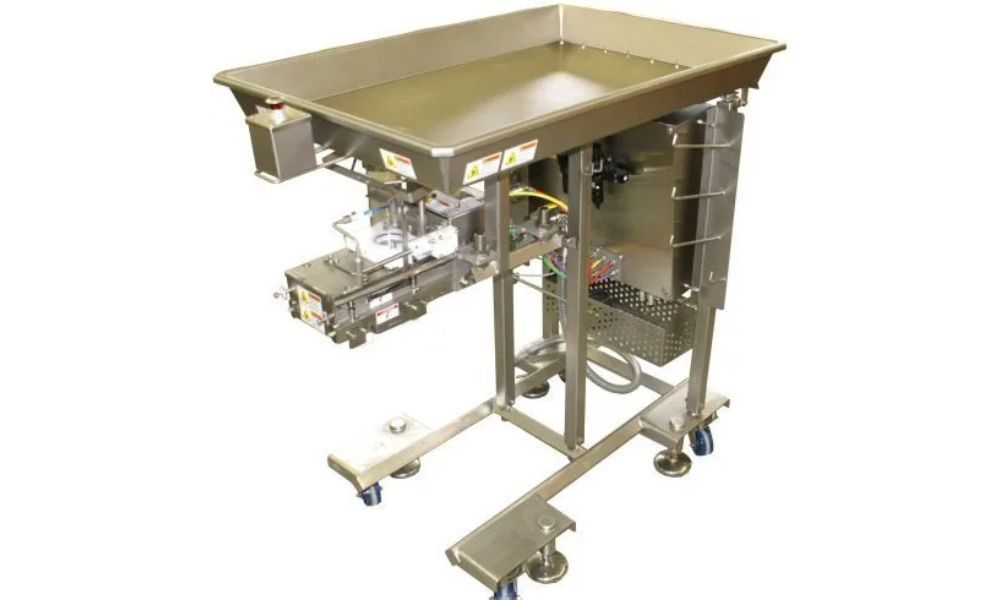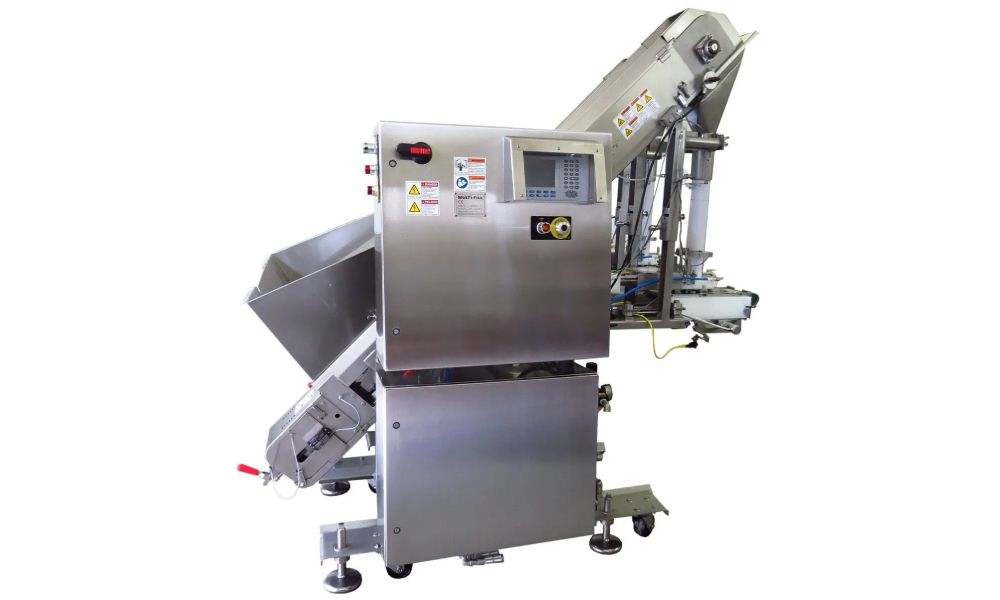Michael Naylor • March 30, 2020
Sanitary Machine Design 101 – Part II
Comprehensive Guide on Hygienic Design for Food Filling Systems (Contd.)

This is Part 2 of a two part series. Find Part 1 here.
In 2007, Peanut Corporation of America faced one of the largest food recalls of all times. They recalled over 3,200 products, and eventually filed for bankruptcy. The virulent salmonella strain that contaminated their products led to 8 deaths and 600 people were ill across 46 states in the US and Canada.
While this was an extremely severe case, even the most minor contamination issue in processed food production and food filling systems can create havoc for your brand or business. From negative publicity, loss of credibility, and recalled stock piles, to customer attrition, expensive lawsuits and hefty fines, you may have to deal with several disasters all at once. However, sanitary machine design minimizes the risks of food contamination, and helps you maintain product quality and consistency, as well as brand reliability.
The principles of sanitary design apply to the food processing equipment, as well as the actual plant or facilities where the production takes place. Essentially, sanitary design is about:
Minimizing the scope for any form of food contamination
Maximizing the ability to maintain hygienic equipment, food filling systems, and facilities
At Multi-Fill, we understand the importance of applying sanitary design principles to food equipment. All our food filling machines are compliant with every feature of sound sanitation. In Part I of the Sanitary Machine Design 101 blog, our machine design experts discussed the various food safety standards, and basic principles of sanitary equipment design. In this blog post, we take a closer look at how the advantages of sanitary machine design extend beyond tackling food contamination. We also offer some suggestions on how to go about purchasing sanitary design equipment and food filling solutions for your processed food facility. MULTI-FILL works actively with customers to improve on a continuous basis.
Why Invest in Sanitary Machine Design?
From the surface design and materials compatibility, to cleaning accessibility and draining facilities, sanitation-friendly food equipment include all the features that prevent contamination, and aid hygiene. Sanitary machine design is not only a prerequisite for food safety, but it also offers a number of other benefits to your business:
- Lower Operating Costs: Sanitary design equipment and facilities clean faster, require fewer chemical cleaning agents, and demand less labor. Their wastewater treatment requirements are also low.
- Higher Productivity: Well-designed, sanitation-friendly machines operate in a manner that reduces scrap and improves yield, allowing you to optimize your resources, increase asset utilization, and improve productivity.
- Improved Personnel Safety: Sanitary design equipment pays a great deal of attention to accessibility for cleaning, maintenance, and inspection purposes. Since it tries to make every part of the machine convenient to disassemble or reintegrate, there is also a sharp focus on reducing any operational hazards. This in turn promises greater personnel safety.
- Protection for Your Brand Reputation: Sound sanitation minimizes the possibility of food contamination, helping you deliver consistently good quality products, and protecting your business from any potential brand erosion.
Investing in Sanitary Equipment Design
Here are some aspects to keep in mind while investing in sanitary machine design for your food filling systems and other equipment:
- The equipment components are easy to disassemble for cleaning, maintenance and inspections.
- The equipment features, particularly in food filling solutions, include adequate ventilation and self-draining facilities, in order to prevent formation of condensation, odor, or mold.
- The equipment conforms to the standards stated by the various domestic and international regulatory bodies that are applicable to your industry.
- Terminology for Making Enquiries: Many of us tend to use the words ‘sanitary design’ and ‘food-grade equipment’ interchangeably. However, ‘food-grade’ may mean different things in the context of equipment construction. To avoid confusion, make enquiries for ‘sanitary machine design’ or ‘sanitary design equipment’.
- Pricing: Depending on the type of machines you need and the standards you choose to adhere to, the price of equipment could be vastly different. For example, a machine that lists itself as ‘stainless steel commercial’ usually means that it features stainless steel construction or components, instead of normal carbon steel. However, such a machine may not necessarily be compliant with your required sanitary design standard. While stainless steel equipment will cost about 25% more than the carbon steel products, sanitary design equipment will probably cost double that of stainless steel ones.
- Evaluation Criteria: While evaluating and shortlisting the equipment, ensure that:
- The equipment components are easy to disassemble for cleaning, maintenance and inspections.
- The equipment features, particularly in food filling solutions, include adequate ventilation and self-draining facilities, in order to prevent formation of condensation, odor, or mold.
- The equipment conforms to the standards stated by the various domestic and international regulatory bodies that are applicable to your industry.
Boost Your Production Quality with Multi-Fill’s Sanitary Design Filling Machines
Multi-Fill’s state-of-the-art volumetric filling machines and batch feed systems
offer the best of sanitary design elements. Not only are our machines extremely easy to clean and disassemble, they prevent products or materials from accumulating food on the contact surfaces, minimizing the possibilities of food contamination.
Additionally, our machines are:
- Compliant with the manufacturing standards stated by major regulatory bodies, such as FDA, ANSI, CE, and USDA.
- Versatile, compact and highly customizable, with filling capabilities of up to 120 cpm.
- Compatible with a wide range of conveyor systems, including intermittent or continuous motion, single or multi-lane containers, and horizontal or vertical bagging systems.
- No tools needed for assembly, disassembly or cleaning.
With innovative designs, smart features, and clean and accurate portioning and dispensing, we serve a wide range of clients across the processed food industry. This includes companies that deal in cooked rice, cooked pastas, prepared salads, cut vegetables and fruits, shredded meats, whole grains, and pet foods.
Learn more about sanitary design in part I of this blog.
For high-speed, sanitary-design, volumetric filling solutions at competitive prices, rely on a recognized industry leader, such as Multi-Fill. Call us at 801-280-1570 or contact us online
to know more about our full suite of products.
Designing a food filling line: Product is king

Food packaging plays a vital role in ensuring the safety and quality of the food we consume. To maintain high standards and prevent foodborne illnesses, the food packaging industry follows a set of regulations known as Current Good Manufacturing Practices (cGMP). In this article, we will delve into cGMP and explore its impact on preventing foodborne illness. We will also take an inside look at how cGMP is implemented on a food factory line, the role of food filling equipment in ensuring compliance, and discuss the future of cGMP in food packaging for strengthening food safety.

Current Good Manufacturing Practices Food safety is of utmost importance in the food industry, and several systems work together to prevent foodborne illnesses. This article explores the harmonization of Current Good Manufacturing Practices (cGMP), Hazard Analysis and Critical Control Points (HACCP), and Hazard Analysis and Risk-based Preventive Controls (HARPC) in ensuring food line safety. We will delve into the synergy between these systems, the role of critical control points, and their practical application in both automatic and manual counting devices. Additionally, we will discuss how cGMP, HACCP, and HARPC optimize automatic filling machines for enhanced food safety. This article is in our series on Current Good Manufacturing Practices. Read the first article here.

In this article, we explore the crucial role of Current Good Manufacturing Practices (cGMP) in ensuring food safety and preventing foodborne illnesses. We'll delve into the significance of hazard analysis and critical control points (HACCP) and how they contribute to mitigating risks. Additionally, we'll discuss the role of Hazard Analysis and Risk-based Preventative Controls (HARPC) in enhancing food safety measures. This is the first in a series of articles on Good Manufacturing Processes in Food Processing. In this article: Understanding the Importance of cGMP in Food Packaging How Hazard Analysis and Critical Control Points (HACCP) Prevent Foodborne Illness The Role of Hazard Analysis and Risk-based Preventative Controls (HARPC) in Food Safety Critical Control Points in Food Packaging The Intersection of cGMP, HACCP, and HARPC in Food Safety









